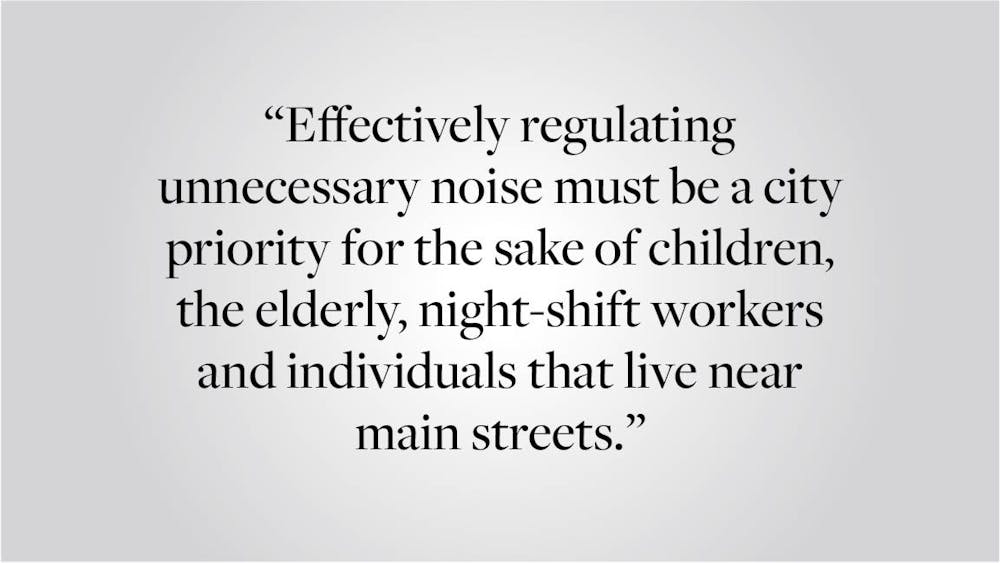I grew up in a house directly adjacent to a noisy street. Honking cars, revving engines and shrieking sirens droned in the background constantly. Similarly, here in Providence, modified cars and motorbikes racing through downtown and on Thayer Street is a common weekend occurrence. Sometimes, my roommate and I cannot hear each other over the sounds of the street.
Noise pollution, or unwanted and disturbing sounds in an environment most often caused by vehicles and machinery, is not just a nuisance. Exposure to noise for prolonged time periods can cause high blood pressure, sleep disturbance and stress, especially in urban areas such as Providence with a greater density of noise. Despite being studied less than other forms of pollution such as air or water, urban noise pollution is a significant public health and environmental justice issue that must be addressed beyond state and municipal governments just setting decibel codes.
Research has demonstrated that exposure to loud noises can raise a person’s heart rate and cause headaches. Although these symptoms can seem temporary, the irritability and blood pressure effects they can cause can contribute to more long-term consequences such as cardiovascular disease and insomnia. Bruitparif, a French nonprofit organization that monitors noise levels in metropolitan Paris, found that some Parisians lose “more than three healthy life-years” connected to exposure to the sounds of cars, trucks, airplanes and trains.
Young children are particularly affected by noise pollution. During critical periods of development, frequent exposure to loud noises can affect a child’s speech acquisition and cognitive function, impairing a child’s ability to learn. In schools and homes located near train tracks or airports, noise pollution can become such a problem that teachers must stop teaching and regain students’ attention each time a noise disturbance occurs. Persistent distractions lead to wasted time and less material learned in class.
The impacts of noise pollution also intersect with other socioeconomic inequities. According to a study from the Harvard T.H. Chan School of Public Health and the University of California, Berkeley, communities with larger proportions of minority residents and socioeconomic inequities experienced higher levels of noise pollution than residents of wealthier cities. Those who live near the nation’s arterial roads are almost always lower income. When viewed alongside literature that has found low income communities face other environmental injustices such as increased air pollution, it can be surmised that noise pollution has the potential to have a significant negative effect on an individual’s ability to maintain their physical, mental and emotional health.
Decibel codes are not enough to contend with the challenges of noise pollution. In Providence, it is currently unlawful to create noises that exceed the sound limit allotted for the city’s various zoning districts. At nighttime in residential areas, the sound limit is 55 decibels, about as loud as a typical conversation. In downtown Providence, the sound limit during the day is 75 decibels, about as loud as a busy restaurant. Not only are these decibel ranges overly optimistic, but they are also difficult to enforce. For example, imagine a car or motorcycle that is booming down Thayer with its mufflers removed. A policeman would need to be present at the moment of infraction, determine which vehicle is responsible and maneuver through narrow streets full of cars and pedestrians — all while potentially ignoring more immediate crimes elsewhere.
Thus, municipal and state governments must invest in longer-term preventative solutions to help regulate noise levels in cities. David Owen, author of Volume Control: Hearing in a Deafening World, suggests building subway cars that roll on rubber tires, directional sirens for emergency vehicles and restricting the extent to which people can modify their vehicles. Owen’s suggestions for medium-sized cities such as Providence include utilizing roadside noise barriers, strategizing the placement of high-rise buildings to act as noise shielding and making roads more friendly for bikers and pedestrians.
Local research and community advocacy in Providence are also necessary to meaningfully reduce noise pollution. Community Noise Lab, for example, is working to study the effects of noise pollution on child health and is actively working with the Providence community to monitor noise levels. One of the Community Noise Lab’s projects is the NoiseScore app, which allows users to “objectively measure and subjectively describe a noise event” and add their responses to a live heat map. These heat maps allow researchers to identify areas with excessive noise and work toward location-specific policy solutions that can reduce noise in those areas. Similarly, the Providence Noise Project, a community advocacy group, is taking strides to address and raise awareness about the consequences of noise pollution in Providence. Volunteers work with researchers and the local government to monitor sound levels and cut down on noise pollution. Together, these two groups are exposing the negative health effects of noise pollution and changing how sound is managed in Providence.
It can be easy to ignore the impact noise pollution has on our lives, but its invisibility doesn’t make it any less important. Effectively regulating unnecessary noise must be a city priority for the sake of children, the elderly, night-shift workers and individuals that live near main streets. Noise affects us all, and failure to address its consequences can only lead to greater public health consequences and environmental injustices in the long term.
Juliet Fang ’26 can be reached at juliet_fang@brown.edu. Please send responses to this opinion to letters@browndailyherald.com and other op-eds to opinions@browndailyherald.com.
Juliet Fang is a second year at Brown studying Ecology and Evolutionary Biology. In her free time, she enjoys running, cycling, and watching duck videos.





